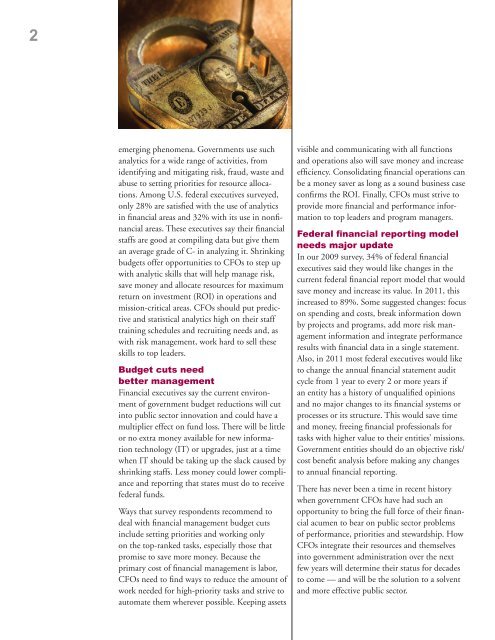CFOs: Surviving in a New Era - AGA
CFOs: Surviving in a New Era - AGA
CFOs: Surviving in a New Era - AGA
You also want an ePaper? Increase the reach of your titles
YUMPU automatically turns print PDFs into web optimized ePapers that Google loves.
2<br />
emerg<strong>in</strong>g phenomena. Governments use such<br />
analytics for a wide range of activities, from<br />
identify<strong>in</strong>g and mitigat<strong>in</strong>g risk, fraud, waste and<br />
abuse to sett<strong>in</strong>g priorities for resource allocations.<br />
Among U.S. federal executives surveyed,<br />
only 28% are satisfied with the use of analytics<br />
<strong>in</strong> f<strong>in</strong>ancial areas and 32% with its use <strong>in</strong> nonf<strong>in</strong>ancial<br />
areas. These executives say their f<strong>in</strong>ancial<br />
staffs are good at compil<strong>in</strong>g data but give them<br />
an average grade of C- <strong>in</strong> analyz<strong>in</strong>g it. Shr<strong>in</strong>k<strong>in</strong>g<br />
budgets offer opportunities to <strong>CFOs</strong> to step up<br />
with analytic skills that will help manage risk,<br />
save money and allocate resources for maximum<br />
return on <strong>in</strong>vestment (ROI) <strong>in</strong> operations and<br />
mission-critical areas. <strong>CFOs</strong> should put predictive<br />
and statistical analytics high on their staff<br />
tra<strong>in</strong><strong>in</strong>g schedules and recruit<strong>in</strong>g needs and, as<br />
with risk management, work hard to sell these<br />
skills to top leaders.<br />
Budget cuts need<br />
better management<br />
F<strong>in</strong>ancial executives say the current environment<br />
of government budget reductions will cut<br />
<strong>in</strong>to public sector <strong>in</strong>novation and could have a<br />
multiplier effect on fund loss. There will be little<br />
or no extra money available for new <strong>in</strong>formation<br />
technology (IT) or upgrades, just at a time<br />
when IT should be tak<strong>in</strong>g up the slack caused by<br />
shr<strong>in</strong>k<strong>in</strong>g staffs. Less money could lower compliance<br />
and report<strong>in</strong>g that states must do to receive<br />
federal funds.<br />
Ways that survey respondents recommend to<br />
deal with f<strong>in</strong>ancial management budget cuts<br />
<strong>in</strong>clude sett<strong>in</strong>g priorities and work<strong>in</strong>g only<br />
on the top-ranked tasks, especially those that<br />
promise to save more money. Because the<br />
primary cost of f<strong>in</strong>ancial management is labor,<br />
<strong>CFOs</strong> need to f<strong>in</strong>d ways to reduce the amount of<br />
work needed for high-priority tasks and strive to<br />
automate them wherever possible. Keep<strong>in</strong>g assets<br />
visible and communicat<strong>in</strong>g with all functions<br />
and operations also will save money and <strong>in</strong>crease<br />
efficiency. Consolidat<strong>in</strong>g f<strong>in</strong>ancial operations can<br />
be a money saver as long as a sound bus<strong>in</strong>ess case<br />
confirms the ROI. F<strong>in</strong>ally, <strong>CFOs</strong> must strive to<br />
provide more f<strong>in</strong>ancial and performance <strong>in</strong>formation<br />
to top leaders and program managers.<br />
Federal f<strong>in</strong>ancial report<strong>in</strong>g model<br />
needs major update<br />
In our 2009 survey, 34% of federal f<strong>in</strong>ancial<br />
executives said they would like changes <strong>in</strong> the<br />
current federal f<strong>in</strong>ancial report model that would<br />
save money and <strong>in</strong>crease its value. In 2011, this<br />
<strong>in</strong>creased to 89%. Some suggested changes: focus<br />
on spend<strong>in</strong>g and costs, break <strong>in</strong>formation down<br />
by projects and programs, add more risk management<br />
<strong>in</strong>formation and <strong>in</strong>tegrate performance<br />
results with f<strong>in</strong>ancial data <strong>in</strong> a s<strong>in</strong>gle statement.<br />
Also, <strong>in</strong> 2011 most federal executives would like<br />
to change the annual f<strong>in</strong>ancial statement audit<br />
cycle from 1 year to every 2 or more years if<br />
an entity has a history of unqualified op<strong>in</strong>ions<br />
and no major changes to its f<strong>in</strong>ancial systems or<br />
processes or its structure. This would save time<br />
and money, free<strong>in</strong>g f<strong>in</strong>ancial professionals for<br />
tasks with higher value to their entities’ missions.<br />
Government entities should do an objective risk/<br />
cost benefit analysis before mak<strong>in</strong>g any changes<br />
to annual f<strong>in</strong>ancial report<strong>in</strong>g.<br />
There has never been a time <strong>in</strong> recent history<br />
when government <strong>CFOs</strong> have had such an<br />
opportunity to br<strong>in</strong>g the full force of their f<strong>in</strong>ancial<br />
acumen to bear on public sector problems<br />
of performance, priorities and stewardship. How<br />
<strong>CFOs</strong> <strong>in</strong>tegrate their resources and themselves<br />
<strong>in</strong>to government adm<strong>in</strong>istration over the next<br />
few years will determ<strong>in</strong>e their status for decades<br />
to come — and will be the solution to a solvent<br />
and more effective public sector.
















